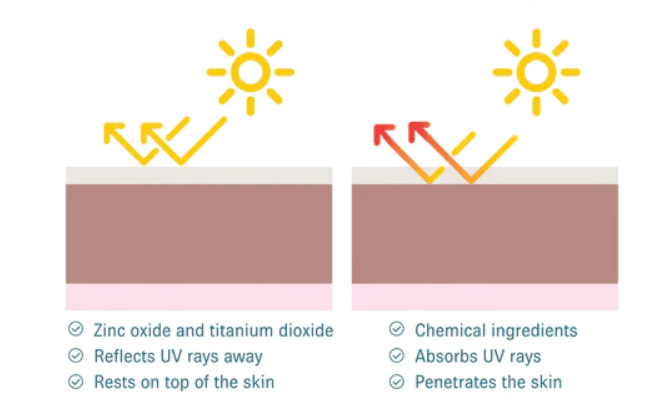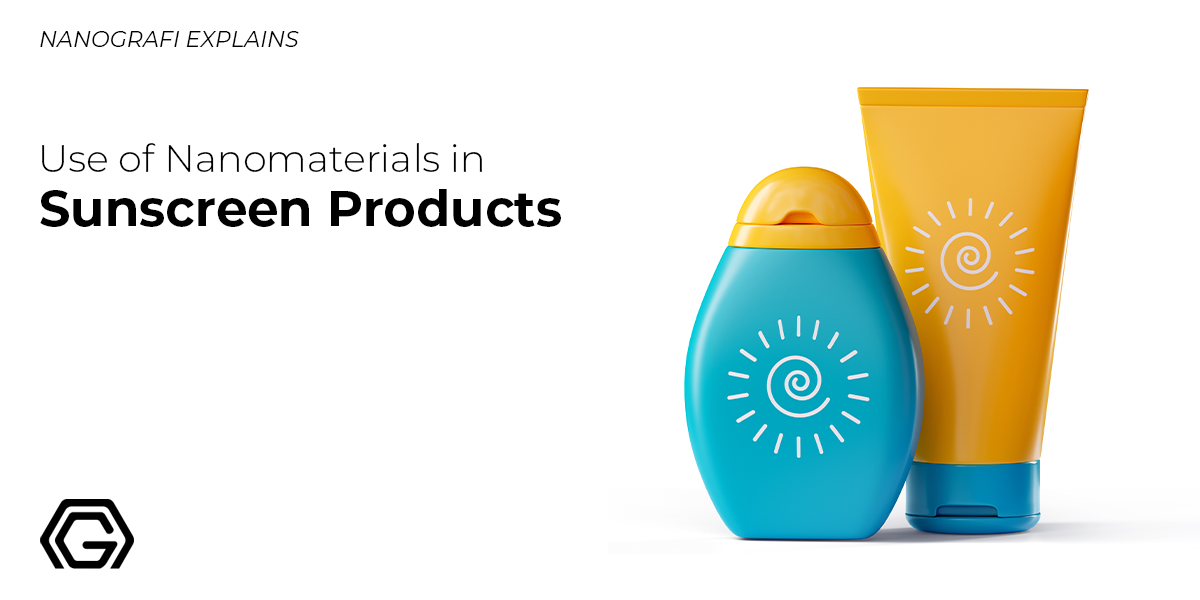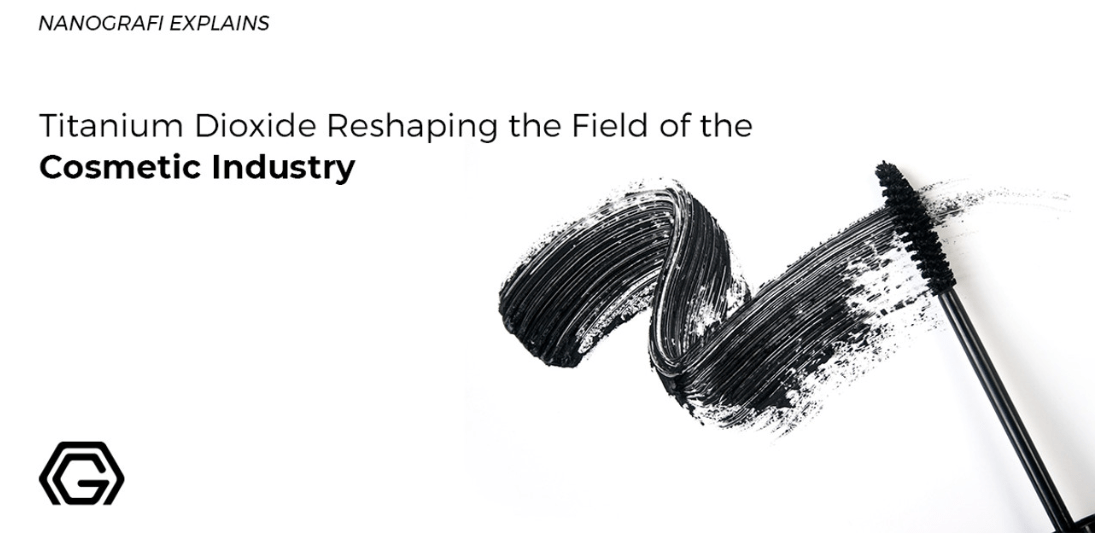Use of Nanomaterials in Sunscreen Products
A transformative shift in sunscreen products has emerged through the integration of nanotechnology, introducing a new era of sunscreen formulations.
Nanomaterials, characterized by their minute size on the nanometer scale, have revolutionized the efficacy, aesthetics, and functionality of sun-care products. Among these, titanium dioxide and zinc oxide nanoparticles have gained considerable attention for their unparalleled ability to shield against harmful ultraviolet (UV) rays. Explore the cutting-edge world of Nanografi's advanced nanomaterials, pioneering solutions across diverse industries.
Introduction
In recent decades, the pursuit of effective sun protection has become paramount in combating the adverse effects of prolonged sun exposure on the skin. Traditional sunscreens, primarily formulated with larger-sized mineral particles like zinc oxide and titanium dioxide, have long been the cornerstone of UV protection.
This article delves into the nuanced realm of nanotechnology in sunscreen products, exploring the properties and mechanisms of titanium dioxide and zinc oxide nanoparticles. It highlights their photoprotective prowess, enhanced cosmetic appeal, and the benefits they offer compared to traditional sunscreen formulations. Additionally, it addresses safety considerations, regulatory frameworks, and the future trajectory of nanomaterials in the sun-care industry. As the significance of sun protection continues to gain prominence in maintaining skin health, understanding the utilization of nanomaterials in sunscreens becomes pivotal. This article aims to unravel the science behind these advancements, shedding light on how nanotechnology has reshaped the landscape of sunscreen products and its implications for the future of skin protection.
The Evolution of Sunscreen Products
The quest for effective sun protection has evolved significantly over the years. Traditional sunscreens offered protection through the use of larger-sized mineral particles like zinc oxide and titanium dioxide. However, the integration of nanotechnology in sunscreen products has revolutionized the efficacy, aesthetics, and application of these formulations.
Traditional Sunscreens: A Foundation for UV Protection
Historically, sunscreens relied on mineral-based ingredients like zinc oxide and titanium dioxide in their larger particle form. These formulations acted as physical barriers, reflecting and scattering UV rays to protect the skin. While effective, they often left a visible white residue, lacked aesthetic appeal, and had limited spreadability on the skin.
Advent of Nanotechnology in Sun Protection
The integration of nanotechnology marked a significant leap forward in sunscreen product development. Nanoparticles, sized between 1 and 100 nanometers, introduced a new era of sunscreens with enhanced properties and improved user experience.
Nanoparticles' reduced size grants them unique properties compared to their bulk counterparts, allowing for improved functionality in various applications. In the realm of sunscreen products, nanoparticles of titanium dioxide and zinc oxide have gained prominence for their exceptional UV-blocking abilities.
Properties of Nanoparticles
Increased Surface Area: Nanoparticles possess significantly larger surface areas relative to their volume. This property enhances their reactivity, allowing for improved interactions with light, chemicals, and biological systems.
Quantum Effects: At the nanoscale, materials often display quantum effects, altering their optical, electrical, and magnetic properties. These effects influence how nanoparticles interact with electromagnetic radiation, such as UV light in the case of sunscreen products.
Altered Mechanical and Chemical Characteristics: Nanomaterials may exhibit altered mechanical strength, thermal conductivity, and chemical reactivity compared to their larger counterparts, leading to unique functionalities in various applications.

Figure 1. Mineral vs. chemical sunscreen.
Nanoparticles and Photoprotective Mechanisms
Mechanisms of UV Protection
Scattering and absorption are two mechanisms by which nanoparticles protect skin from UV radiation. In scattering, nanoparticles scatter incoming UV rays, reducing their penetration into the skin and dispersing them harmlessly. In absorption, nanoparticles absorb UV rays, converting them into less harmful forms of energy like heat, or emitting them at longer, safer wavelengths.
Safety Considerations and Research
Ongoing research is assessing the potential for nanoparticle penetration into the skin's deeper layers and their possible effects on human health upon skin contact. Concurrently, there are concerns about the environmental impact of nanomaterials used in sun-care products. These concerns focus on their effects on marine life and ecosystems when washed off into water bodies, with studies examining the environmental fate and toxicity of these nanoparticles.
Regulatory Oversight and Guidelines
Regulatory bodies like the FDA and the European Commission continually evaluate nanomaterials' safety and efficacy in sun-care products. Strict guidelines ensure their safe usage, mandating thorough testing and labeling requirements for products containing nanoparticles. Understanding the unique properties and mechanisms of nanomaterials, particularly titanium dioxide and zinc oxide nanoparticles, is fundamental in appreciating their pivotal role in enhancing the effectiveness and aesthetics of sun-care products while addressing associated safety and regulatory considerations.
Titanium Dioxide Nanopowders: Shielding Skin from Harmful UV Rays
Titanium dioxide (TiO2) nanoparticles, with their nano-sized dimensions, possess enhanced light-scattering properties, resulting in superior UV protection. The reduction in particle size enables better coverage and transparency on the skin, overcoming the opaque appearance associated with larger particles in traditional formulations. The nanoscale dimensions of titanium dioxide particles enhanced their ability to scatter and absorb both UVA and UVB rays effectively. This advancement significantly elevated the sun protection factor (SPF) and broadened the spectrum of protection, making them more efficient at preventing sun-induced skin damage.
Photoprotective Mechanism of Titanium Dioxide Nanoparticles
When exposed to UV radiation, titanium dioxide nanoparticles efficiently absorb and scatter both UVA and UVB rays. Their unique structure facilitates the conversion of harmful UV rays into less damaging forms of energy, thus minimizing skin damage caused by prolonged sun exposure.
Zinc Oxide Nanopowders: The Versatile Sun Shield
Zinc oxide (ZnO) nanoparticles have also garnered attention in sun-care products due to their broad-spectrum UV protection. Their smaller size grants improved transparency compared to conventional zinc oxide, offering a more aesthetically pleasing application without the white cast commonly associated with larger particles. Furthermore, the enhanced UV-scattering properties of zinc oxide nanoparticles ensured broad-spectrum protection against both UVA and UVB rays. This made them invaluable in providing long-lasting and effective defense against sun damage.
Protective Properties of Zinc Oxide Nanoparticles
Zinc oxide nanoparticles create a physical barrier on the skin's surface, effectively scattering and absorbing both UVA and UVB rays. Their photo-stable nature ensures prolonged protection against UV radiation, making them a valuable component in sunscreens designed for extended outdoor activities.
To learn about the use of Titanium Dioxide in cosmetics, read blog.
Benefits of Nanoparticles in Sunscreen Products
The integration of nanomaterials in sunscreens presents several advantages over conventional formulations:
Enhanced Efficacy
Nanoparticles exhibit improved UV-blocking efficiency due to their increased surface area-to-volume ratio. This enhancement translates into higher SPF (Sun Protection Factor) values and better protection against sun-induced skin damage.
Improved Aesthetics
The smaller particle size of nanomaterials allows for better spreadability and reduced whitening effect upon application. These characteristics addresses one of the primary consumer concerns associated with traditional sunscreens. Sunscreens incorporating nanoparticles provide a cosmetically elegant texture, enhancing user compliance and comfort.
Better Skin Compatibility
Nanoparticles facilitate a more cosmetically elegant texture, leading to increased user compliance. Additionally, advancements in surface coating techniques have minimized potential skin irritations, making nanomaterial-based sunscreens suitable for sensitive skin types.
Safety Considerations and Regulatory Oversight
Despite their numerous advantages, the use of nanomaterials in sun-care products has raised concerns regarding potential health and environmental impacts. Regulatory bodies worldwide closely monitor these materials to ensure consumer safety.
Safety Assessment and Risk Mitigation
Extensive research endeavors focus on assessing the safety profile of nanomaterials used in sunscreens. Studies evaluate their potential for skin penetration, toxicity, and environmental impact to establish safe usage guidelines.
Regulatory Frameworks
Regulatory agencies, such as the U.S. Food and Drug Administration (FDA) and the European Commission's Scientific Committee on Consumer Safety (SCCS), continually review and update guidelines to ensure the safe utilization of nanomaterials in sun-care products. Compliance with these stringent regulations is essential for manufacturers to bring their products to market.
Future Trends and Innovations
The evolution of nanotechnology in sunscreen products remains a dynamic field with ongoing innovations and advancements. Future research focuses on developing novel nanomaterials with improved UV-blocking abilities, exploring sustainable production methods, and integrating nanocarriers for targeted delivery of active ingredients. These endeavors aim to further enhance sun-care formulations while addressing safety and environmental concerns. The field of nanotechnology in sun-care products continues to evolve, with ongoing research focusing on:
- Development of novel nanomaterials with enhanced UV protection and improved stability.
- Integration of nanocarriers for targeted delivery of active ingredients, boosting sunscreen effectiveness.
- Sustainable production methods and environmentally friendly formulations to address ecological concerns.
Conclusion
In conclusion, the utilization of nanomaterials, specifically titanium dioxide and zinc oxide nanoparticles, represents a paradigm shift in sun protection. Their transformative impact on sunscreen formulations has redefined the standards for efficacy, aesthetics, and user comfort. As technology continues to progress, the synergy between nanotechnology and sun-care products holds promise for continually improving skin protection against the harmful effects of solar radiation.
Nanomaterials, particularly titanium dioxide and zinc oxide nanoparticles, have revolutionized the sun-care industry by providing superior UV protection with improved aesthetics. While their benefits are apparent, ongoing research and regulatory oversight are crucial to ensure the safety and efficacy of these innovative formulations. Incorporating nanotechnology in sunscreen products represents a milestone in providing effective and cosmetically elegant solutions for protecting the skin against the damaging effects of solar radiation. As technology advances and safety measures continue to improve, nanomaterials will likely play an increasingly significant role in the development of next-generation sunscreens.
We, Nanografi, follow all the developments in the field of nanotechnology and work harder every day to take our place in the technology of the future.
References
Analyzed: Titanium Oxide - Nanografi Nano Technology. (n.d.). Retrieved January 9, 2024, from https://nanografi.com/blog/analyzed-titanium-oxide-/
Fundamental Properties and Applications of Zinc Oxide Nanoparticles - Nanografi Nano Technology. (n.d.). Retrieved January 9, 2024, from https://nanografi.com/blog/fundamental-properties-and-applications-of-zinc-oxide-nanoparticles/
Gupta, V., Mohapatra, S., Mishra, H., Farooq, U., Kumar, K., Ansari, M. J., Aldawsari, M. F., Alalaiwe, A. S., Mirza, M. A., & Iqbal, Z. (2022). Nanotechnology in Cosmetics and Cosmeceuticals—A Review of Latest Advancements. Gels, 8(3). https://doi.org/10.3390/GELS8030173
Nano Coatings: The Ultimate Barrier for UV and NIR Radiation - Nanografi - Nanografi Nano Technology. (n.d.). Retrieved January 9, 2024, from https://nanografi.com/blog/nano-coatings-the-ultimate-barrier-for-uv-and-nir-radiation-nanografi/
Nanomaterials in sun-care products - ScienceDirect. (n.d.). Retrieved January 9, 2024, from https://www.sciencedirect.com/science/article/abs/pii/B978012822286700022X
Nanoparticles in sunscreens | EWG’s Guide to Sunscreens. (n.d.). Retrieved January 9, 2024, from https://www.ewg.org/sunscreen/report/nanoparticles-in-sunscreen/
Nasir, A., Wang, S., & Friedman, A. (2011). The emerging role of nanotechnology in sunscreens: an update. Expert Review of Dermatology, 6(5), 437–439. https://doi.org/10.1586/EDM.11.49
Titanium Dioxide Reshaping the Field of the Cosmetic Industry - Nanografi - Nanografi Nano Technology. (n.d.). Retrieved January 9, 2024, from https://nanografi.com/blog/titanium-dioxide-reshaping-the-field-of-the-cosmetic-industry-nanografi-/
Why Is Nanotechnology Used In Sunscreen | Science-Atlas.com. (n.d.). Retrieved January 9, 2024, from https://science-atlas.com/faq/why-is-nanotechnology-used-in-sunscreen/
Zinc Vs. Titanium SPF - What’s The Difference? – All Things Beach Co. (n.d.). Retrieved January 9, 2024, from https://allthingsbeachco.com.au/blogs/about-finding-bella/zinc-vs-titanium-spf-whats-the-difference
Recent Posts
-
Advanced Materials for Unmanned Aerial Vehicle (UAV) Protection Against Laser
Consider a UAV on a critical mission, rendered inoperative by a sudden laser attack. With the increa …26th Jul 2024 -
Simulation and Modeling of Material Properties
Our world is composed of a dazzling array of materials, each with its own unique properties that dic …19th Jul 2024 -
Advanced Coatings for Superior Corrosion and Wear Resistance
Corrosion and wear pose significant challenges across various industries, leading to substantial eco …12th Jul 2024







